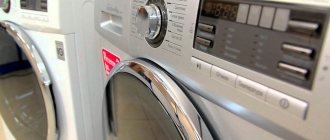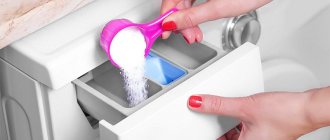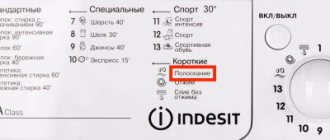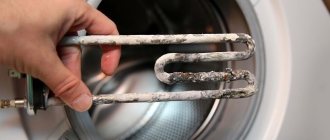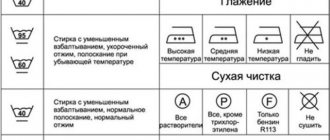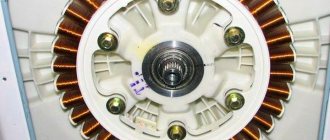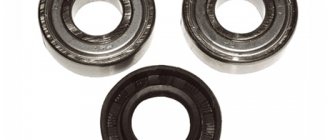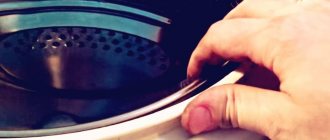Regular washing leads to the appearance of excess moisture in the drum, mold, bacteria and fungi appear, as a result, the quality of the wash deteriorates and parts break prematurely. Standard rinsing does not completely eliminate breeding spots, so it is necessary to clean the washing machine, especially if there is no self-cleaning function.
Washing hygiene
Automatic washing machines are designed to save the owner from unnecessary hassle. But are they really independent? You load clothes into the drum, add powder, press a button and after a while you get clean clothes. Particles of dirt, lint, threads and pet hair remain in the drum.
Only part of this small debris enters the filtration system and is discharged into the sewer. Tiny fractions settle on the walls, where they become an ideal environment for the proliferation of pathogenic fungi and bacteria.
You load new clothes, and all this microflora ends up on things, because the standard washing mode involves heating the water only in the range of 30-60°C. This temperature is not enough to kill pathogens.
Care instructions
Periodic cleaning of the drum is just one link in a whole chain of unit care procedures.
IMPORTANT! This element of the device can be called a kind of indicator, which is convenient for determining whether other parts of the machine need cleaning.
Look into the drum and inspect it carefully - if there are traces of scale or dirty deposits on the walls, then the internal parts of the device will be in even worse condition, and cleaning should be started immediately.
Learn more about how to clean elastic in the washing machine.
In addition to the drum, the following parts require regular maintenance:
- drainage system (filter and hose);
- water supply system to the unit (inlet filter, hose);
- rubber seal located between the device door and the drum;
- heating element.
Self-cleaning washing machine
The eco drum cleaning function does not require the addition of any cleaning agents or disinfectants; the machine cleans everything on its own. The cleaning cycle is carried out at a temperature of 70 degrees for 90 minutes.
This allows you to disinfect the inside of the device, remove scale, mold and unpleasant odors - it is impossible to change these parameters, they are set automatically by the electronics of the washing machine.
The eco-drum cleaning program makes it possible not only to maintain hygiene inside the device, but also significantly extends the performance of the unit. In addition, by regularly cleaning the washing machine, you will save energy, because the electric heater is also cleaned of plaque adhering to it, and, therefore, heats the water much faster and more efficiently.
What buttons and selectors are there?
Any Indesit SMA has the following elements on the control panel:
- Program switch. There are icons on the panel, duplicated with pictures. The consumer turns the selector to select the desired option.
- Temperature switch. If the user selects a specific program, the temperature is set automatically. But thanks to the selector, you can adjust the water heating.
- Speed switch. The rotation speed of the drum can also be changed - in any direction.
- Start/stop or on/off button. Activates and deactivates the machine. Near the button there is an LED indicating the state of the device.
Also on Indesit machines, depending on the model, there are additional buttons:
- 50% load. It is pressed if you need to wash several items. Saving water and electricity.
- Reducing the spin speed. Use for delicate fabrics.
- Super rinse. For thorough rinsing.
- Cold wash. For delicate materials and not very dirty things.
- Disabling spin.
How does the drum clean function work?
Cleaning looks like a regular wash without laundry and consists of several stages:
- The pre-wash mode is activated.
- The main mode or cleaning starts at 60 degrees with speeds up to 150 rpm.
- The program ends with a double rinse and a spin at the highest possible speed.
To prevent the formation of plaque and clogging, it is enough to carry out preventive cleaning of the drum twice a month. We strongly recommend that you clear the drain filter of debris before starting this function.
Important! Using this cycle does not remove or prevent scale.
Adviсe
Before starting the automatic cleaning mode, it is a good idea to inspect for blockages and, if necessary, clean the drain hose and filter.
Complete cleaning of the drum requires additional cleaning of the elements in contact with it. So, with the drum, the rubber seal of the hatch is cleaned of dirt and soap deposits .
Wipe the cuff on all sides with a soft sponge. A toothbrush will help clean hard-to-reach places.
Alternating cleaning with professional and folk remedies will help you achieve the best results - a perfectly clean drum and adjacent elements of the washing machine.
Scope of application of the cleaning function
The drum, where stale laundry is placed and where detergents get in, is more susceptible to contamination than other parts of the washing machine.
It also comes into contact with hard, poorly filtered water containing harmful impurities:
- Iron,
- Technical, edible oils,
- rust,
- Chlorine,
- Calcium and magnesium salts.
With frequent use of the machine, especially in large families, the drum constantly remains wet, with puddles and smudges. An environment favorable for the development of microorganisms and bacteria that pose a threat to health is formed. The situation is aggravated by the habit of some housewives of storing dirty clothes directly in the washing machine.
Why do you need to clean the washing machine drum?
The drum, when dealing with dirty laundry, becomes dirty over time. In washing machines without automatic cleaning, you have to do it yourself. To do this, pour bleach, vinegar, citric acid into the machine, add soda or other cleaning and disinfectants.
Thanks to treatment with cleaning agents, the drum gets rid of dirt, bacteria, mold, scale, unpleasant odors and soap deposits. If you don’t clean the “inside” of the machine in time, a putrid smell will emanate from it, and washed items will also smell like it.
If you neglect the cleanliness of the SMA, it will fail prematurely. If you bought a model with Eco, you don’t have to use special cleaning products or run the washing machine empty - the device will take care of its cleanliness.
More: Description and characteristics of Bosch Maxx 5 Speed Edition
Ambulance
There are many products available on store shelves to combat drum contamination. By choosing ready-made products, you will spend less time and effort fixing the problem. There is also an alternative method, more economical, but just as effective. For help you should turn to folk recipes.
The most popular substances used at home:
- Citric acid copes well with stains and is included in most cleaning products offered in stores.
- Acetic acid is similar in principle to citric acid.
- Baking soda - used in conjunction with other ingredients.
- Bleach is ideal for eliminating unpleasant odors.
- Copper sulfate - used for disinfection treatment, eliminates mold and mildew.
If your washing machine does not have a self-cleaning drum mode
It is necessary to familiarize yourself with the list of detergents recommended by the manufacturer for cleaning the drum, specified in the operating instructions for your washing machine. As a last resort, you can use “folk remedies”. But, of course, it is worth remembering that they can be used rarely and with extreme caution.
How to clean a washing machine drum with citric acid
Pour 100-200 g of citric acid (depending on the load of your model) into the powder compartment and turn on the wash at high temperature and high speed.
How to clean a washing machine drum with vinegar
Pour 250 ml of 9% vinegar into the powder compartment. Activate the high temperature wash function. After the mixture of water and vinegar has warmed up, pause the wash for 60 minutes, then resume the process and complete it. After finishing the process, keep the hatch open and let the vinegar smell disappear from the machine.
How to clean a washing machine drum with soda
Mix 200 g of soda and 200 g of water (in a one to one ratio). Apply the resulting slurry to the drum of the machine, the glass of the hatch cover from the inside, and also to the rubber cuff of the hatch. Leave the mixture in the machine for half an hour and then remove with a damp sponge. Then start the rinse mode in the machine.
How to clean a washing machine drum with chlorine
Pour 250 ml of 0.5% chlorine solution into the powder compartment. Turn on the wash at the highest temperature and high speed.
If you have any doubts that during cleaning the drum, the product you used remains on the internal parts of the washing machine, then you should start the washing mode again (after maintaining the time interval specified in the instructions for your LG washing machine). Otherwise, it may lead to damage to the laundry in the future.
How to clean a washing machine drum with powder
Applicable to:
- Front-loading washing machine (integrated or freestanding),
- Top loading washing machine.
Solution:
- Remove all laundry from the drum
- Select the Cotton program and set the temperature to the highest possible
- Add a small amount of powder detergent to the empty drum to remove any remaining dirt.
From time to time, at the end of the cycle, the icon may appear on the display.
– it notifies that it is recommended to clean the drum.
When the drum is cleaned, the icon disappears.
Warranty terms The warranty does not apply to...
- Image
- Text
29
terms of guarantee
U
The warranty does not apply to:
• Visits from the repair service to teach how to use the purchase. • If any voltage other than the recommended one is used
for a car.
• If the device is damaged as a result of an accident or natural disaster
disasters.
• If the device is damaged due to improper use, do not
instructions provided for by the rules.
• The device is used before reading the instructions or parts,
included in the kit are replaceable.
• If the appliance is damaged due to pets or rats, cockroaches or
etc.
• The usual noises and vibrations for the device appear: the sound of merging
water, drying sound, warning signals.
• The warranty does not include installation of the device or connection of hoses. • The warranty will not include maintenance recommended in the instructions. • The supplier is not obligated to remove foreign objects from the machine, including
pump, filters, nails, wires, screws, etc.
• The supplier does not undertake to replace plugs or change cables in the home. • The supplier does not undertake to correct the consequences of unqualified
repair.
• Damage to personal property, directly or indirectly caused by
was caused by a possible malfunction of the device.
• The warranty does not cover cases where the product is used in commercial
purposes. (For example: public places such as toilet, hotel, training center, rental house)
Disposal of old equipment
1. The symbol on the device that shows a crossed line
wheelie bin means that the product is subject to Directive 2002/96/EC.
2. Electrical and electronic devices must
not be disposed of with household waste, but through special places designated by government or local authorities.
3. Proper disposal of old equipment will help
prevent potentially harmful effects on the environment and human health.
4. For more details about the old
equipment, contact your city administration, recycling service or the store where you purchased the product.
Comments
Highlight → I found instructions for my home here! #manualza
Click →
From the instructions for using a gas mask: - Pull until the point is in front of the eye!
Manualza!manualza.ru
Still not with us?
https://youtube.com/watch?v=HZxOxnVgPCQ
https://youtube.com/watch?v=SSlaqRaItko
Preventing drum contamination
Dampness and warm temperature in the washing machine after washing are a favorable environment for the appearance of fungus and mold. Debris, dirt and unwashed detergents, settling on the rubber door seal, drain hose, filter and powder tray, cause germs to multiply.
Also, washing items heavily soiled with greasy substances leads to the settling of undissolved sediments on the drum, tank and rubber cuffs.
The source of drum contamination is often limescale. Due to the presence of salts and impurities in running water, an insoluble precipitate forms when heated. As a result, the heating elements are covered with a layer of scale, which increases over time, preventing thermal conductivity. This affects the quality of water heating and energy consumption.
To prevent dirt and scale, you must:
- Wash at high temperature at least once a week, but up to 75 degrees, since scale formation begins at this value;
- wash out any remaining detergent from the tray;
- wipe the hatch seal dry;
- 1-2 times every 2-3 months (depending on the operation of the machine), carry out preventive cleaning with citric acid or vinegar;
- ventilate the tank after washing, leaving the hatch ajar for an hour to an hour and a half.
Taking into account the feedback from washing machine repair specialists, models with a drum cleaning function are kept in a neater condition and are less prone to breakdowns. This is explained by the fact that users are more willing and often to clean the machine of accumulated dirt with this program, since it does not require cleaning agents or physical effort.
Cleaning the inlet hose filter
You are almost certainly faced with a clogged problem if your washing machine is slow to fill. The filter of the device captures debris from the water supply, prevents it from entering the machine and protects the internal parts. It is possible that it is clogged with mineral deposits and tiny particles of debris.
Contamination occurs most often after repairs to the water supply system (both in an apartment and in a public network). Any work on water supply lines increases sediment in the pipes, and, as a result, on the filters. And it’s worse if the hose is clogged. This component of the washing machine is more difficult to clean.
Cleaning the filter is not difficult. The only thing you need to be careful when you remove the filter. Don't yank it. Gently squeeze and twist as you pull towards yourself. If it bends a little, return it to its original shape by straightening it with your fingers.
Tip: If there are too many lime deposits on the filter, it is unlikely that you will be able to wash it. Buy a new one: they are inexpensive and sold at plumbing stores.
What you need to prepare before cleaning the filter:
- screwdriver 4 in 1;
- needle nose pliers;
- utilitarian knife.
The procedure is as follows:
1. Turn off the water, disconnect the hoses.
2. Use a pair of pliers to remove the filter. 3. Remove sand and debris from it. Pry out the stuck particles with a knife. 4. Rinse under water or blow with a hairdryer. 5. Put the filter in place by pressing on the rim with a screwdriver. 6. With hoses and water, do everything in reverse order: connect the hoses, turn on the water, checking for leaks.
Self-cleaning washing machines
Most modern models of washing machines from the brands LG, Samsung, Haier, Hotpoint, Electrolux, Gorenje, Haier, Ariston, Beko, Indesit and many others are equipped with a self-cleaning function.
For example, the BEKO WMI71241 model - with its classic design and maximum load of up to 7 kilograms of laundry, is equipped with a self-cleaning program - that is, washing with an empty drum at high temperature without detergents.
The LG F-1296ND3 model, a very popular built-in model designed to load 6 kg of laundry, also has this capability.
Manufacturers of the LG brand have made a special series “Direct Drive” - the models of which have at least 10 programs (depending on how much the car costs, their number varies), among which there is self-cleaning.
What's better?
When choosing between using the automatic cleaning mode and alternative (improvised, store-bought) means, you need to analyze the pros and cons of each method.
So, using improvised products or store-bought compounds will help restore cleanliness and freshness to the walls of the drum, regardless of whether the washing machine is equipped with a self-cleaning mode or not.
The means at hand (soda, citric acid) are absolutely harmless to health and are as affordable as possible. The only negative that may affect the choice is that using an excessive amount of cleaning agent can destroy the rubber seal around the hatch and dull the gloss of the drum walls.
The “self-cleaning” function allows you to quickly, efficiently and, most importantly, safely clean the inner surface of the drum without human intervention. Among the disadvantages, it is worth noting the high energy consumption (the “self-cleaning” program takes place at the highest possible temperatures for a long time).
